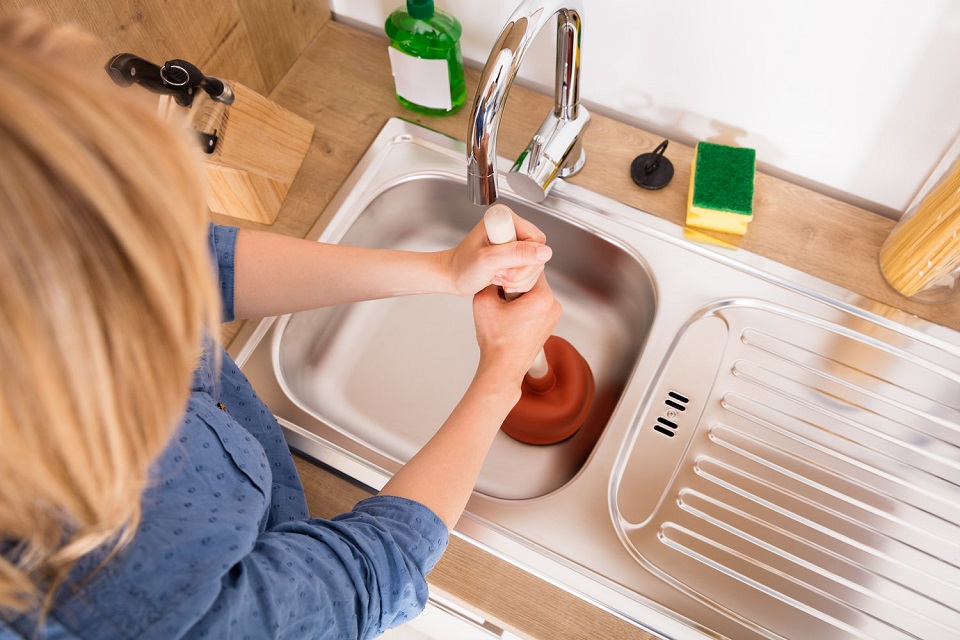Table of Contents
Clogged drains are one of the most common plumbing problems. While some clogs may require professional help, most can be addressed with household items such as baking soda and vinegar.
If plunging doesn’t work, use a plumber’s snake (or auger) to break up and pull the clogged material out of the pipe. Then flush the drain with hot water.
Plunger
Clogged drains are a common household problem. They handle all the water and waste from sinks, bathtubs, and toilets, and with all that material going down them, they will inevitably clog occasionally. Clearing drain clogs without hiring a plumber and spending money is easy with simple steps.
The most basic method to fix a clogged drain involves using a plunger. This tool is a flexible rubber bell or cone-shaped device with an operating handle that forces air into the drain pipes to push a clog onward. Before using it:
- Ensure the drain and surrounding area are completely dry.
- To unclog a drain, place the plunger cup over it and pump rapidly.
- After several rounds of this, check to see if the water is flowing freely down the drain again.
If the plunger fails to do the trick, it may be time to try a more robust method. You can buy a wire drain snake or a “plumber’s snake” at a hardware store. It is a coiled wire with a broader end that can be fed down the drain and crank-turned to break up or pull out the clog. If you decide to use this technique, remove any pop-up assembly in the drain and run hot water down the pipe while you work to flush away any loosened debris.
Plumber’s Snake
Grease is a common culprit for kitchen sink drain clogs. Food scraps, coffee grounds, eggshells, and more can contribute to the grease buildup that impedes water flow. To help keep your drains free of grease, install a drain stopper or a filter in your sink and throw away large food scraps instead of washing them down the drain. Also, run water for a minute after you wash dishes or get out of the shower.
If plunging the drain doesn’t work, try a chemical drain cleaner. Products like Liquid Plumbr or Drano contain strong chemicals that eat away at what is causing the clog, typically food residue or excess grease. While these products usually unclog your drain, they can damage your pipes if misused.
If you still have a stubborn clog, it’s time to break out the snake. A plumber’s snake is a coiled wire tool you can send down the drain and hook onto obstructions. You crank the handle on the drum that holds the snake to thrust it down the pipe until you feel resistance. Running hot water over the snake while snaking is vital so that any broken-up clog material is flushed away from your pipes. A drain snake can be purchased at most home improvement stores for around $20.
Wire Coat Hanger
A simple wire coat hanger can do wonders in a pinch when struggling with a drain that won’t budge. Just straighten the hanger out as best possible, then bend one end over to create a hook. Push the hook down the drain and start fishing. The hook should grab onto whatever is clogging the drain, and you can pull it up from the pipe once you’ve pulled up as much gunk as you can and run hot water down the drain to flush it.
Alternatively, you can use a power drill to dislodge the clog. Typically, these tools are available at home improvement stores. Plugging the drill in and positioning it near your drain, then feeding a few feet of cable down the drain, will get things moving. Most of these tools have a foot-pedal switch, which leaves both hands free to guide the cable along the pipe. Eventually, the clog will break up or fall away.
If you’ve tried everything from a plunger to a drain snake, but your clogged drain remains, it may be time to call in the pros.
Wet/Dry Vacuum
A wet/dry vacuum, readily available at hardware and big box stores that rent equipment, can be a quick way to solve moderate drain clogs. The force and heat from the hot water, when it’s used correctly, can often break away or pull out stubborn gunk concentrations that are blocking your pipes.
This tool can also effectively dislodges a clog caused by soap scum, grease, or hair. With the sink’s overflow hole blocked and a rag or piece of cardboard placed over the drain opening to create a seal, place the end of your wet/dry vacuum hose against the clogged pipe and turn on the unit. Creating a good seal is essential to avoid damaging your vacuum and the plumbing.
When clogs don’t go away or are too severe for any of the above DIY methods, it may be time to call a professional plumber.
Boiling water may also be able to clear certain types of clogs. Pour a cup of table salt and boiling water down the drain, then wait 15 minutes while it foams; flush with more boiling water afterward to complete the process.





No Comments